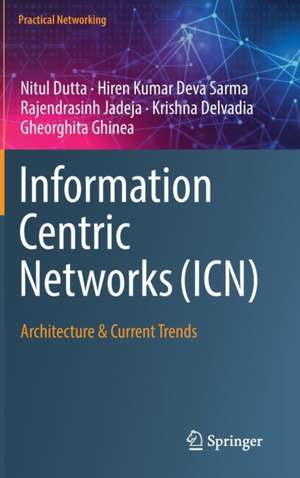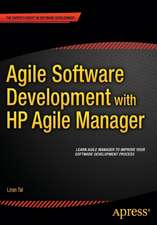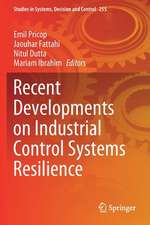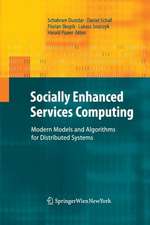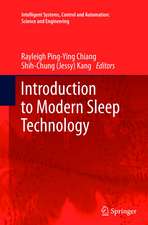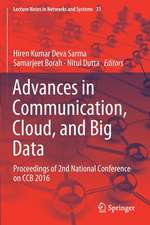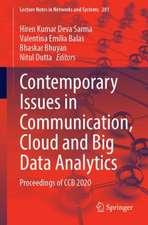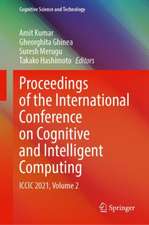Information Centric Networks (ICN): Architecture & Current Trends: Practical Networking
Autor Nitul Dutta, Hiren Kumar Deva Sarma, Rajendrasinh Jadeja, Krishna Delvadia, Gheorghita Ghineaen Limba Engleză Hardback – 28 aug 2021
The book includes three unique chapters in the field of ICN research. The first, is the SDN framework for implementing ICN by decoupling data and control plan. The machine learning models for predicting future trends in network traffic and other management activities is another important chapter. This chapter includes the possibilities of using machine learning models for trend prediction to help network administrators and service providers to take care of unexpected sudden change traffic pattern and user behaviour. The third most vital chapter is the security issues in ICN. This chapter includes various facts that influences the security of ICN. Issues involved in naming, caching and routing are discussed separately along with few recent works in these areas. Various types of attacks in ICN are also part of the discussion.
The stated book would be useful for researchers in this area and will work as a reference for future work. Moreover, the content of the book would also be suitable as a supporting material for undergraduate and graduate level courses in computer science and electrical engineering.
| Toate formatele și edițiile | Preț | Express |
|---|---|---|
| Paperback (1) | 1153.13 lei 6-8 săpt. | |
| Springer International Publishing – 29 aug 2022 | 1153.13 lei 6-8 săpt. | |
| Hardback (1) | 1159.42 lei 6-8 săpt. | |
| Springer International Publishing – 28 aug 2021 | 1159.42 lei 6-8 săpt. |
Preț: 1159.42 lei
Preț vechi: 1449.27 lei
-20% Nou
Puncte Express: 1739
Preț estimativ în valută:
221.88€ • 230.79$ • 183.18£
221.88€ • 230.79$ • 183.18£
Carte tipărită la comandă
Livrare economică 15-29 aprilie
Preluare comenzi: 021 569.72.76
Specificații
ISBN-13: 9783030467357
ISBN-10: 303046735X
Ilustrații: VII, 194 p. 39 illus.
Dimensiuni: 155 x 235 mm
Greutate: 0.46 kg
Ediția:1st ed. 2021
Editura: Springer International Publishing
Colecția Springer
Seria Practical Networking
Locul publicării:Cham, Switzerland
ISBN-10: 303046735X
Ilustrații: VII, 194 p. 39 illus.
Dimensiuni: 155 x 235 mm
Greutate: 0.46 kg
Ediția:1st ed. 2021
Editura: Springer International Publishing
Colecția Springer
Seria Practical Networking
Locul publicării:Cham, Switzerland
Cuprins
1. Introduction to information centric networks.- 1.1 Introduction.- 1.2 Internet Architecture: Strengths and Limitations.- 1.2.1 Content distribution networks.- 1.3 Content Distribution Network Architecture.- 1.4 Characteristics of ICN, Design Principles, and Assumptions.- 1.4.1 Characteristics of ICN.- 1.4.2 Design Principles.- 1.4.3 Assumptions.-1.5 Key Building Blocks of ICN and Design Challenges.- 1.5.1 Key Building Block of ICN.- 1.5.2 Design Challenges..-1.6 Benefits of using ICN.- 1.7 Historical note on ICN.- Architectures for content communication.- 2.1 Introduction.-2.2 Representative ICN Architectures.- 2.2.1 TRIAD Architecture.- 2.2.2 DONA Architecture.- 2.2.3 Content Centric Network (CCN) Architecture.- 2.2.4 PURSUIT Architecture.- 2.2.5 Network Information (NetInf) architecture.- 2.2.6 The NDN architecture.- 2.3 Comparative analysis of ICN Architectures.- 2.4 Software Defined Networking in ICN.- 2.4.1 Scope ofintegrating SDN into ICN.- 2.4.2 The SDN architecture in general..- 2.5 Summary.- 3 Naming for unique content identification.- 3.1 Introduction.- 3.2 Naming system design.- 3.3 Importance of naming.- 3.4 key design issues and choices for information/content naming for ICNs.- 3.5 Naming approaches proposed so far.- 3.5.1 CBCB (Combined broadcast and content based routing).- 3.5.2 DONA (Data oriented network architecture).- 3.5.3 NetInf (Network of information).- 3.5.4 NDN (Named data networking).- 3.5.5 PURSUIT (Publish subscribe Internet technologies).- 3.5.6 Hierarchical and flat based hybrid naming scheme in CCN IoT.- 3.5.7 Secure naming scheme for Information Centric Networks.- 3.6 Analysis of naming schemes along with their advantages and disadvantages.- 3.6.1 Flat vs. hierarchical vs. attribute value-based naming approaches.- 3.6.2 Name based routing vs. Name resolution.-3.6.3 Incremental vs. Clean slate approach.- 3.7 Need of an efficient content naming mechanism: Our perspective.- 3.8 Open research in ICN Naming.- 3.9 Summary.- 4 Routing schemes used in content delivery.- 4.1 Introduction.- 4.2 Realization of routing in ICN.- 4.3 Realization of Forwarding in ICN.- 4.4. NDN forwarding architecture with illustration.- 4.5. Stateful forwarding paradigm for NDN.- 4.6. OSPFN: An OSPF based routing for NDN.- 4.6.1 Routing in OSPFN.- 4.7 NLSR: A Secure Link State Routing protocol for NDN.- 4.7.1 Naming scheme.- 4.7.2 Format of LSAs.- 4.7.3 Dissemination of LSAs.- .7.4 Adjacency Establishment.- 4.8 Recent development in ICN Routing.- 4.9 Open Research in ICN routing.- 4.10 Summary.- Caching mechanisms for faster content retrieval. - 5.1 Introduction.- 5.1.1 General overview of network caching.- 5.2 Research challenges and issues in ICN caching.- 5.2.1 Unique naming of content and caches.- 5.2.2Popularity of data.- 5.2.3 Limited storage space in caching devices.- 5.2.4 Storage location.- .2.5 Staleness or freshness detection of content.- 5.2.6 Repeated caching of same Content.- 5.2.7 Content Mobility.- 5.2.8 New research challenges for ICN caching.- 5.3 Recent trends in Caching.- 5.3.1 In-Network caching.- 5.3.2 Edge Caching.- 5.3.3 SDN based Caching.- 5.4 Performance metrics along with objectives in terms of caching mechanisms for ICN.- 5.4.1 Cache hit ratio and server load.- 5.4.2 Content retrieval latency.- 5.4.3 Retransmission ratio for interest packets.- 5.4.4 Total cache evictions.- 5.4.5 Diversity Metric.- 5.4.6 Cache retention ratio.- 5.5 Analysis of various caching methods.- 5.6 Open research in ICN caching.- 5.7 Summary.- 6 Security in ICN.- 6.1 Introduction 6.2 Importance of Security in ICN 6.3 Key Security & privacy concerns in ICN architectures 6.4 Attacks in ICN 6.4.1 Naming related attacks.- 6.4.2 Routing related attacks. 6.4.3 Caching related attacks. 6.4.4 Content poisoning attack.- 6.4.5 Miscellaneous attacks.- 6.5 ICN attributes leading to security threats.- 6.6 Security mechanisms adopted in ICN.- 6.6.1 Countermeasures for naming attacks.- 6.6.2 Countermeasures for routing attacks.- 6.6.3 Countermeasures for caching attacks.- 6.6.4 Countermeasures for content poisoning attacks.- 6.6.5 Countermeasures for miscellaneous attacks.- 6.7 Open research in ICN security.- 6.8 Conclusion.- 7. Optimization in ICN.- 7.1 Introduction.- 7.2 The need of optimization in ICN.- 7.3 Approaches for optimization in ICN.- 7.4 Machine learning for optimization in ICN.- 7.4.1 Application of ML in Communication Networks.- 7.4.2 Application of ML in Information Centric Networks.- 7.5 Open research directions for optimization in ICN.- 7.6 Conclusion.- 8. A framework for integrating SDN in ICN.- 8.1 Introduction.- 8.2 State of the art work in SDN based ICN.- 8.3 The SDN architecture for ICN.- 8.3.1 Based on OpenFlow over CONET.- 8.4 Proposed architecture.- 8.4.1 Functional description.- 8.4.2 Routing in the proposed model.- 8.4.3 Caching in the proposed model.- 8.5 Analysis of the proposed architecture.- 8.6 Future research direction in SDN enable ICN.- 8.7 Summary.- Integrating content communication into real life applications.- 9.1 Introduction.- 9.2 Recent trends in ICN applications.- 9.3 Information centric networks in Internet of things.- 9.3.1 Adaptation of information centric networks for internet of things (IoT) : Challenges and opportunities.- 9.4 Information centric networks in smart grid.- 9.5 Information centric networks in wireless sensor networks.- 9.6 Information centric networks in mobile adhoc networks.- 9.7 Information centric networks in vehicular adhoc networks.- 9.8 Open research in the field of content centric real life applications.- 9.9 Summary.
Notă biografică
Nitul Dutta is currently working as a Professor in the Computer Engineering department at Marwadi Unniversity, Rajkot, Gujarat. He received his B.E. degree in Computer Science and Engineering from Jorhat Engineering College, Assam (1995) and M. Tech. degree in Information Technology from Tezpur University Assam (2002). He completed his Ph.D. (Engineering) degree in the field of Computer Networking from Jadavpur University, West Bengal (2013). He also worked as a Post-Doctoral Fellow (PDF) at Jan Wyzykowski University, Polkowice, Poland, during the period 2017-2018. His current research interests are computer networks, mobility management in IPv6 based networks, cognitive radio and information centric networks. He has published four books in Springer book series and several journal papers in the area of computer networking. He is a senior member of IEEE and vice-chair of IEEE CIS Gujarat section.
Hiren Kumar Deva Sarma is currently Professor in the Department of Information Technology, Sikkim Manipal Institute of Technology, Sikkim. He received B.E. degree in Mechanical Engineering from Assam Engineering College in 1998. He completed Master of Technology in Information Technology from Tezpur University in 2000. He received Ph.D. degree from Jadavpur University (Department of Computer Science and Engineering) in 2013. He is a recipient of Young Scientist Award from the International Union of Radio Science (URSI) awarded in the XVIII General Assembly 2005, held at New Delhi, India. Dr. Sarma received IEEE Early Adopter Award in the year 2014. He has published more than seventy research papers in different International Journals, referred International and National Conferences of repute. His current research interests are wireless sensor networks, mobility management in IPv6 based network, cognitive radio networks, ICN, network security, robotics, distributed computing and big data analytics.
Rajendrasinh Jadeja is working as a Dean at the Faculty of Engineering, Marwadi University - Gujarat, India. He is undergoing Post-Doctoral Fellow (PDF) at Jan Wyzykowski University, Polkowice, Poland. He completed his B.E. in Electrical Engineering from L. D. College of Engineering (Gujarat University) in 1998, M.Tech in Electrical Engineering from Nirma University and a PhD from the M S University, Baroda. He has been awarded the title “ING.PAED.IGIP” in 2020 and also a Senior Member of IEEE. He is working as a Treasurer of IEEE India Council and also worked as a Chair of IEEE Gujarat Section during the Year 2017-2018.The areas of Research and Interest include control of power electronic converters, AC drives, Pulse Width Modulated power electronic converters and Power Quality Issues and its mitigation techniques. Various projects have been undertaken and have completed a project funded by GUJCOST (Gujarat Council on Science & Technology) and he is working on a project making “Deep Learning and AI skills” mainstream in India to fulfil trilateral needs of entrepreneurship, Industry-academia partnership and application-inspired Engineering Research. He actively participates and initiates ERASMUS+ for staff mobility and has also completed such a program for teaching between partner countries.
Krishna Delvadia, currently working as an Assistant Professor in Information Technology department of Chhotubhai Gopalbhai Patel Institute of Technology, Uka Tarsadia University, Bardoli, Gujarat, India. She completed her B.E degree in Information Technology from Marwadi Education Foundation Group of Institutions, Gujarat, India. She received her M.E degree in computer engineering from Marwadi Education Foundation Group of Institutions, Gujarat, India and She is currently pursuing a PhD in the field of Information Centric Networks from Marwadi University, Gujarat, India. Her current area of research includes Mobile Adhoc networks, WirelessNetworks, Internet of Things and Distributed Computing and Information centric Networks.
Gheorghita Ghinea is a Professor in the Computer Science Department at Brunel University, United Kingdom. He received the B.Sc. and B.Sc. (Hons) degrees in Computer Science and Mathematics, in 1993 and 1994, respectively, and the M.Sc. degree in Computer Science, in 1996, from the University of the Witwatersrand, Johannesburg, South Africa; he then received the Ph.D. degree in Computer Science from the University of Reading, United Kingdom, in 2000. His work focuses on building adaptable cross-layer end-to-end communication systems incorporating user perceptual requirements. His work has been funded by both national and international funding bodies – all of it being collaborative work with other teams and stakeholders he has been privileged to be involved with. He has been honoured to supervise 24 PhD students to completion and to have published over 300 high-quality research articles with them and other research collaborators. He is a member of the IEEE and the British Computer Society.
Textul de pe ultima copertă
This book aimed at bringing an insight to the ICN network, particularly various architectures, issues and challenges in the new networking paradigm. The book starts with an introduction to the new promising concept of ICN and its origin along with the reason behind this interesting innovation. Different architectures proposed so far in support of implementing the ICN is also discussed in details. Few of the challenges of ICN implementation are enlisted as caching, naming, routing, and security. Each of these challenges with recent development is covered in individual chapters. Moreover, integration of current trends in communication and computing like software defined networking and machine learning approach are another area that this book is focusing. All these chapters highlight the recent developments reported in the area and also discusses the future trends. The book provides an overview of the recent developments in future internet technologies, bringing together the advancements that have been made in ICN.
The book includes three unique chapters in the field of ICN research. The first, is the SDN framework for implementing ICN by decoupling data and control plan. The machine learning models for predicting future trends in network traffic and other management activities is another important chapter. This chapter includes the possibilities of using machine learning models for trend prediction to help network administrators and service providers to take care of unexpected sudden change traffic pattern and user behaviour. The third most vital chapter is the security issues in ICN. This chapter includes various facts that influences the security of ICN. Issues involved in naming, caching and routing are discussed separately along with few recent works in these areas. Various types of attacks in ICN are also part of the discussion.
The stated book would be useful for researchers in this area and will work as a reference for future work. Moreover, the content of the book would also be suitable as a supporting material for undergraduate and graduate level courses in computer science and electrical engineering.
The book includes three unique chapters in the field of ICN research. The first, is the SDN framework for implementing ICN by decoupling data and control plan. The machine learning models for predicting future trends in network traffic and other management activities is another important chapter. This chapter includes the possibilities of using machine learning models for trend prediction to help network administrators and service providers to take care of unexpected sudden change traffic pattern and user behaviour. The third most vital chapter is the security issues in ICN. This chapter includes various facts that influences the security of ICN. Issues involved in naming, caching and routing are discussed separately along with few recent works in these areas. Various types of attacks in ICN are also part of the discussion.
The stated book would be useful for researchers in this area and will work as a reference for future work. Moreover, the content of the book would also be suitable as a supporting material for undergraduate and graduate level courses in computer science and electrical engineering.
Caracteristici
Offers a comprehensive study on Information Centric Networks as well as recent developments and future trends. Discusses security issues and optimization techniques. Presents machine learning algorithms for ICN management.
